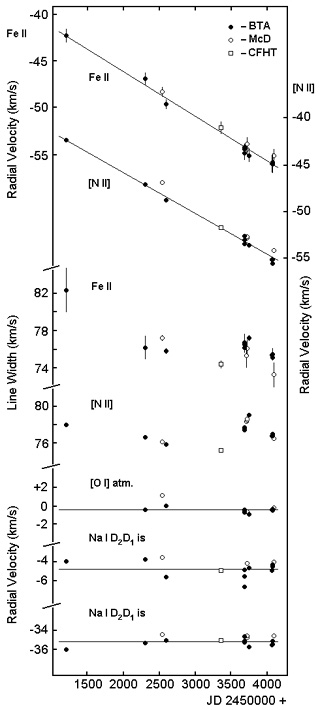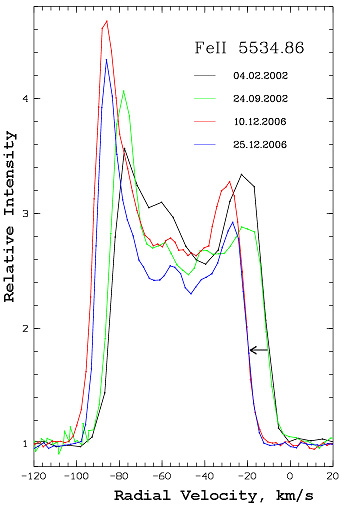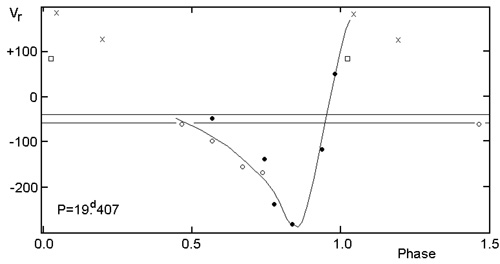Discovery of the acceleration in the wind emission lines of CI Cam
E.A. Barsukova, V.G. Klochkova, V.E. Panchuk, M.V. Yushkin (SAO, Russia),
V.P. Goranskij (SAI, Moscow Univ.),
A.S. Miroshnichenko (Univ. of North Carolina at Greensboro, USA),
K.S. Bjorkman (Ritter Obs., Univ. of Toledo, USA),
N. Manset (CFHT Team, Hawaii, USA)
Short report to be published in Astronomer's Telegram. Details.
CI Cam (XTE J0421+560) is an X-ray transient and a binary system the
optical companion, which shows the B[e] phenomenon. Its strong all-wavelength outburst
occured in 1998 April. The system consists of a B4 III-V star and a
possible white dwarf on an eccentric (e = 0.62) orbit with the period of
19.407 day (ATel #416; Astronomy Reports, 2006, V.50, 664).
We analysed seventeen echelle spectra (resolution FWHM=0.08-0.21A)
taken with Russian 6-m telescope BTA (LYNX and NES spectrographs),
CFHT (ESPaDOnS spectrograph), McDonald 2.1-m (Sandiford spectrograph)
and 2.7-m (cs2 spectrograph) telescopes. The spectroscopic observations
were performed between 1999 January 27 and 2006 December 25. The centroid
velocities of the following emission lines were measured: FeII (5 lines),
[N II] 5754.59A (NIST Database), H_alpha, H_beta, HeI (5 lines),
and [O III] 5006.843A. FeII and [N II] lines that form in the cool
equatorial disk wind of B[e] star have stable sharp-edge profiles.
The velocity dispersion measured in individual spectra using
the set of five FeII lines varies between 0.4 and 1.0 km/s.
To check the accuracy of the stellar velocities and heliocentric corrections,
we also measured centroid velocities of narrow telluric [O I] emission
line and two components of interstellar NaI D_2,D_1 absorption lines.
All the FeII lines and the [N II] line in our spectra show a linear shift
with time. The line profiles shift as a whole, and their edges move
synchronously. These shifts do not correlate with the phase of the
19.41 day period. The acceleration is equal to -1.70 +/-0.06 km/s per
year in the FeII lines, and -1.60 +/-0.06 km/s per year in the [N II] line.
The Balmer and HeI lines show a similar velocity shift tendency,
which is measured with a lower accuracy due to an additional short-term
(days) variability of the lines' shape and velocity.
The shift of lines may evidence for the third companion in the system
of CI Cam. The FeII line velocity changed between -55.7 and -42.3 km/s
during the last 7.9 years, and this shift is seen around the
gamma-velocity of -51 km/s of the 19.407-day HeII-line velocity curve
(this period is confirmed with our high-resolution spectra).
This indicates the B4 type star and its line forming region along with
its compact companion is passing now the exterior conjunction of its
orbit around invisible companion.
The orbital period of the latter should be over 40 years. Therefore
the system of CI Cam is hierarchic. But such a shift in the [N II]
forbidden line is surprising. This line was the only one which has
not strengthened in the April 1998 outburst. Its intensity began to rise
only 20 days after the X-ray peak and reached maximum with the time
delay of 210 +/-20 days. The radius of its forming region may be as
large as 150-200 AU. It is hard to imagine a regular acceleration
of such a large nebula.

Figure 1.
The radial velocity curves for FeII and [N II] emission lines
(top).
The dependence of FeII and [N II] line width on time
(middle).
The velocity curves for check lines: telluric [O I] emission
line, and two components of interstellar Na I D absorption lines
(bottom).

Figure 2.
The samples of FeII wind line profiles plotted against heliocentric
radial velocity show the line shift for the last four years (marked
by arrow).

Figure 3.
The radial velocity curve (in km/s) of HeII 4686A line with the
19.407 day period plotted using high resolution spectra. Filled circles
are BTA data, open circles are McDonald data, square is a
CFHT spectrum, crosses are two most reliable middle
resolution spectra. The ranges of FeII line velocity variations
are plotted by two horizontal lines.
View the collection of UBV(RjRc) photometry of CI Cam. Needs a Java
compatible brouser. Use mouse function mouseDrag to examine the
detailes.
Download photometric data (VBURj/Rc).
Astronomer's Telegram #416.
Astronomy Reports V.50, 664.
NIST Atomic Spectra Database
Paper on CI Cam to VAC-2004 Conference in Moscow.
Home page.



